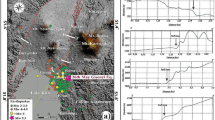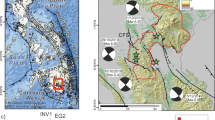Abstract
We estimated the source parameters for local earthquakes near the Idukki reservoir, Kerala. The region falls under seismic zone III, indicating moderate seismicity, and is reported to have witnessed several small to moderate size magnitude earthquakes. Eight local earthquakes with magnitudes ranging between 2 and 3.6 were used during the data analysis of this study. Four key parameters were primarily estimated from the earthquake signals, providing an overall idea about the source characteristics, i.e., seismic moment, stress drop, corner frequency, and source radius. Our estimated moment magnitudes (Mw) range between 2 and 3.4, which are consistent with the reported local magnitude (ML) scale, indicating a minor difference between MW and ML scale. The estimated variations in seismic moment align well with the global model of micro-earthquakes, ranging between 1.2E + 15 and 1.1E + 17 dyn-cm. The source radius mostly varies between 110 and 220 m, with seismic moment exhibiting a linear increase as source size grows. This suggests a clear dependence of seismic moment on the radius of the source. It is likely that the brittle shear-failure mechanism on the fault segment and/or the presence of weak zones would contribute to local earthquakes with smaller source radius. Stress drops for most of the events are relatively low in the study region, ranging from 0.3 to 4.5 bars. The initiation of rupture is evident along an existing fault plane, potentially acting as a contributing factor to the observed lower stress drop values. The stress drop variable with a positive correlation to the seismic moment of the event might indicate a wide range of strength of the crustal rock in the region. Interestingly, both the corner frequency (fc) and maximum frequency (fmax) decrease as seismic moment increases, indicating that both are related to the source process and possibly influenced by the site effects. Finally, we can suggest that the derived source parameters can be utilized to simulate ground motion parameters of historical events, thereby enhancing seismic hazard assessment and facilitating earthquake engineering analyses in future research initiatives.







Similar content being viewed by others
References
Aki K (1988) Physical theory of earthquakes. In: Bonnin J, Cara M, Cisternas A, Fantechi R (Eds) Seismic Hazard in Mediterranean Region, pp 3–33
Anderson JG (1991) A preliminary descriptive model for the distance dependence of the spectral decay parameter in southern California. Bull Seismol Soc Am 81(6):2186–2193
Beresnev IA, Atkinson GM (1997) Modeling finite–fault radiation from the xn spectrum. Bull Seismol Soc Am 87(1):67–84
Biswas K, Mandal P (2017) Modeling of source parameters and moment tensors of local earthquakes occurring in the eastern Indian shield. J Geol Soc India 89:619–630
Bora DK, Baruah S, Biswas R, Gogoi NK (2013) Estimation of source parameters of local 596 earthquakes originated in shillong-mikir plateau and its adjoining region of Northeastern 597 India. Bull Seismol Soc Am 103:437–446. https://doi.org/10.1785/0120120095
Brune JN (1970) Tectonic stress and the spectra of seismic shear waves from earthquake. J Geophys Res 75:4997–5009
Brune JN (1971) Correction to tectonic stress and the spectra of seismic shear waves from earthquakes. J Geophys Res 76:5002
Chen X, Zhang H (2001) An efficient method for computing Green’s functions for a layered half–space at large epicentral distances. Bull Seismol Soc Am 91(4):858–869
De Luca G, Scarpa R, Filippi L, Gorini A, Marcucci S, Marsan P, Milna G, Zambonelli E (2000) A detailed analysis of two seismic sequences in Abruzzo, central Apennines, Italy. J Seismol 4:1–21
Hanks TC (1982) Fmax. Bull Seismol Soc Am 72:1867–1879
Hanks TC, Kanamori H (1979) A moment magnitude scale. J Geophys Res 84:2348–2350
Hartzell S, Harmsen S (1999) Calculation of broadband time histories of ground motion: comparison of methods and validation using strong-ground motion from the 1994 Northridge earthquake. Bull Seismol Soc Am 89(6):1484–1504
Irikura K (1986) Prediction of strong acceleration motion using empirical Green’s function. Proc. 7th Japan Earthquake Symp 151:151–156
Kamae K, Irikura K, Pitarka A (1998) A technique for simulating strong ground motion using Hybrid Green’s function. Bull Seismol Soc Am 88(2):357–367
Karimzadeh S, Funari MF, Szabó S, Hussaini SS, Rezaeian S, Lourenço PB (2024) Stochastic simulation of earthquake ground motions for the seismic assessment of monumental masonry structures: Source-based vs site-based approaches. Earthq Eng Struct 53(1):303–314
Keilis-Borok VI (1960) Investigation of the mechanism of earthquakes. Sov Res Geophys 4:29
Khan PK, Bhukta K, Mandal P (2020) Estimation of source parameters of local earthquakes based on inversion of waveform data. Curr Sci 119:1159–1168
Kumar A, Kumar A, Gupta SC, Mittal H, Kumar R (2013) Source parameters and f max in Kameng region of Arunachal Lesser Himalaya. J Asian Earth Sci 70:35–44
Kumar R, Gupta SC, Kumar A, Mittal H (2015) Source parameters and f max in lower Siang region of Arunachal lesser Himalaya. Arab J Geosci 8:255–265
Liu S, Jiang Y, Qiao K, Peng L, Liu D (2023a) Record-based simulation of three-component long-period ground motions: hybrid of surface wave separation and multivariate empirical mode decomposition. Soil Dyn Earthq Eng 172:108037–108053
Liu Y, Zhao X, Wen Z, Liu J, Chen B, Bu C, Xu C (2023b) Broadband ground motion simulation using a hybrid approach of the May 21, 2021 M7.4 earthquake in Maduo, Qinghai China. Earthq Sci 36(3):175–199
Mai PM, Imperatori W, Olsen KB (2010) Hybrid broadband ground-motion simulations: combining long-period deterministic synthetics with high-frequency multiple S-to-S backscattering. Bull Seismol Soc Am 100:2124–2142
Mandal P, Dutta U (2011) Estimation of earthquake source parameters in the Kachchh Seismic Zone, Gujrat, India, from strong-motion network data using a generalized inversion technique. Bull Seismol Soc Am 4:1719–1731
Mandal P, Jhonston A (2006) Estimation of source parameters for the aftershocks of the 2001 Mw Bhuj earthquake, India. Pure Appl Geophys 163:1537–1560
Mandal P, Saha S, Kumar S, Gupta S, Biswas R et al (2022) Modelling of moment tensors and source parameters of the 25 July 2021 rare lower crustal Hyderabad (India) earthquake of Mw 3.9. Pure Appl Geophys 179:993–1010
Mayeda KM, Walter WR (1996) Moment, energy, stress drop and source spectra of Western U.S. earthquakes from regional coda envelopes. J Geophys Res 101:11195–11208
Mittal H, Kumar A, Wu YM, Kamal KA (2016a) Source study of Mw 5.4 April 4, 2011 India-Nepal border earthquake and scenario events in the Kumaon-Garhwal Region. Arab J Geosci 9:1–5
Mittal H, Wu YM, Chen DY, Chao WA (2016b) Stochastic finite modeling of ground motion for March 5, 2012, Mw 4.6 earthquake and scenario greater magnitude earthquake in the proximity of Delhi. Nat Hazards 82:1123–1146
Motazedian D, Atkinson GM (2005) Stochastic finite–fault modeling based on a dynamic corner frequency. Bull Seismol Soc Am 95(3):995–1010
Ozmen E, Karimzadeh S, Askan A (2020) Broadband ground motion simulation within the city of Düzce (Turkey) and building response simulation. Pure Appl Geophys 177(5):2353–2373
Peng Y, Luo C, Qiu C, Kong F (2023) Stochastic simulation of velocity pulses of near-fault ground motions based on multivariate copula modeling. Probab Eng Mech 72:103434
Rajendran K (1995) Sensitivity of a seismically active reservoir to low amplitude fluctuations: observations from Lake Jocassee, South Carolina. Pure Appl Geophys 145:87–95
Rajendran K, Thulasiramanand K, Sreekumari K (2013) Micro earthquake activity near the Idukki Reservoir, South India: a rare example of renewed triggered seismicity. EngGeol 153:45–52
Rastogi BK (2001) Erattupettah earthquake of 12 December 2000 and seismicity of Kerala. J Geol Soc India 57:27–274
Ristau J, Roggers GC, Cassidy JF (2003) Moment magnitude- Local magnitude calibration for earthquakes off Canada’s West Coast. Bull Seismol Soc Am 93:2296–2300
Saikia U, Rai SS (2017) Seismicity pattern, reference velocity model and earthquake mechanics of South India. Bull Seismol Soc Am. https://doi.org/10.1785/0120160369
Saikia U, Rai SS, Subrahmanyam M, Dutta S, Bose S, Bora K, Meena R (2014) Accurate location and focal mechanism of small earthquakes near Idukki Reservoir, Kerala implication for earthquake genesis. Curr Sci 107:1885–1891
Sandhu M, Sharma B, Mittal H, Yadav RB, Kumar D, Teotia SS (2020) Simulation of strong ground motion due to active Sohna fault in Delhi, National Capital Region (NCR) of India: an implication for imminent plausible seismic hazard. Nat Hazards 104(3):2389–2408
Singh R, Khan PK, Singh AP (2020) Earthquake source dynamics and Kinematics of the Eastern Indian Shield and adjoining regions. Solid Earth Sci 68:337–355
Sivaram K, MaheshreddyGade RSTG, Saikia U, Nagaraju K (2017) Estimation of strong ground motion in Southern Peninsular India by empirical Green’s function method. Curr Sci 112(11):2273–2283
Süle B (2010) Spectral source parameters for weak local earthquakes in the Pannonian basin. Central Eur J Geosci 2(4):475–480
Trifu CI, Radulian M (1991) Frequency magnitude distribution of earthquakes in southern Sicily, Italy. Bull Seismol Soc Am 96:4301–4311
Tsai CP, Chen KC (2000) A model for the high-cut process of strong-motion accelerations in terms of distance, magnitude, and site condition: an example from the SMART 1 array, Lotung Taiwan. Bull Seismol Soc Am 90(6):1535–1542
Tusa G, Brancato A, Gresta S (2006) Source parameters of micro-earthquakes in southern Sicily, Italy. Bull Seismol Soc Am 96:968–983
Upadhayay SK, Ahuja VK (1981) Source parameters of earthquakes in Northeast India from spectra of Rayleigh waves. Tectonophysics 75:297–315
Wu ZL, Chen YT, Mozaffari P (1999) Scaling of stress drop and high-frequency fall-off of source spectra. Acta Seismol Sin 12(5):507–515
Acknowledgements
This article is part of Semester project work of Anjaly S Menon. The dataset used here from the Phd work of Dr. Utpal Saikia. The authors express their gratitude to CSIR-NGRI for operating the seismic stations utilized in this research. The authors extend their sincere appreciation to all individuals from CSIR-NGRI who contributed during the field deployment phase. The graphical representations in this work were generated using the Generic Mapping Tools (GMT) as detailed in the publication by Wessel and Smith in 1998. Utpal Saikia acknowledges the financial support of the Ramanujan fellowship research grant provided by SERB-DST. The authors also extend thanks to Dr. Andrzej Górszczyk, the Editor-in-Chief, and two anonymous reviewers, whose suggestions greatly contributed to the enhancement of this article.
Author information
Authors and Affiliations
Corresponding author
Ethics declarations
Conflict of interest
On behalf of all authors, the corresponding author states that there is no conflict of interest.
Additional information
Edited by Dr. Andrzej Górszczyk (ASSOCIATE EDITOR) / Prof. Ramón Zúñiga (CO-EDITOR-IN-CHIEF).
Rights and permissions
Springer Nature or its licensor (e.g. a society or other partner) holds exclusive rights to this article under a publishing agreement with the author(s) or other rightsholder(s); author self-archiving of the accepted manuscript version of this article is solely governed by the terms of such publishing agreement and applicable law.
About this article
Cite this article
Saikia, U., Menon, A.S., Das, R. et al. Estimation of source parameters of local earthquakes originated near Idukki Reservoir, Kerala. Acta Geophys. (2024). https://doi.org/10.1007/s11600-024-01348-w
Received:
Accepted:
Published:
DOI: https://doi.org/10.1007/s11600-024-01348-w




